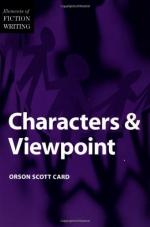|
This section contains 644 words (approx. 2 pages at 400 words per page) |

|
Characters and Viewpoint Summary & Study Guide Description
Characters and Viewpoint Summary & Study Guide includes comprehensive information and analysis to help you understand the book. This study guide contains the following sections:
This detailed literature summary also contains Topics for Discussion and a Free Quiz on Characters and Viewpoint by Orson Scott Card.
The book is subtitled "How to invent, construct, and animate vivid, credible characters and choose the best eyes through which to view the events of your short story or novel." In exploring this intent, the book offers several suggestions of techniques writers can employ to bring fictional characters to vivid life in order to fully engage a reader in the story being told. These suggestions are grounded in the key thematic premises relating to the necessity for justification, the importance of the narrative's relationship with the reader, and the value of craft.
After a brief introduction (in which the author refers to writing as a solitary art and discusses different aspects of fiction writing), the author begins the first part of his analysis (subtitled "Inventing Characters") with basic descriptions of what a character is and the function that a character fulfills in a narrative. He then goes into a detailed analysis complete with illustrations (taken from both fictional and dramatic writing) of various techniques for developing effective and engaging characters. Also in this first section he analyzes and comments on various useful sources for characters (life, research, narrative context and/or requirements, among others).
In Part Two of his analysis ("Constructing Characters"), the author introduces and defines what he calls his MICE theory of narrative analysis, with the four letters of MICE standing for the four basic components of any narrative. M represents milieu (physical location, social and community-defined characteristics associated with that location), while I represents idea (the story and/or thematic premise being played out and/or explored by the narrative). C represents character (the individuals playing out the narrative and the way those individuals change over the course of the narrative), and E represents event (incidents, confrontations, etc that trigger that process of change and manifest the idea). Also in this section, he contends that transformation has become an essential component of contemporary narrative, and presents his hierarchy of characters (the relative importance of the various kinds of characters as defined by the effect they have on the narrative).
An important component of the author's analysis in this section is his contention that at the beginning of every narrative, a writer establishes a contract with the reader to answer the questions posed by the narrative, and to write in a consistent style and from a consistent point of view. The most important part of the contract, he suggests, is that the writer must ensure that event, character and theme are all developed and presented in a justified, logical manner that will ultimately feel true to the reader. He reinforces this central thematic point by suggesting here and throughout the book that the purpose of any narrative is to bring a reader to a deeper, truer understanding of the human experience and condition.
Part 3 of the book is subtitled "Performing Characters." In this section, the author compares the value of presentation (reminding the reader s/he is being told a story) with representation (drawing the reading into the story), and contrasts dramatic (showing) with narrative (telling) technique. He also analyzes various ways of defining a character's individualized voice and perspective, and discusses how that voice can be utilized in supporting and/or defining the perspective of a narrator. This, in turn, leads to an in-depth discussion of various narrative perspectives—first person/third person, past tense/present tense, limited/omniscient point of view, cinematic/light/deep penetration and insight.
The author draws his book to a conclusion by suggesting that the possibilities for creating, defining and utilizing characters in a narrative situation are almost infinite. He adds that a writer is capable of an unlimited capacity to surprise and engage a reader, and that ultimately that surprise is valuable in opening the experience of a reader to a new perspective on him/herself and/or the world.
Read more from the Study Guide
|
This section contains 644 words (approx. 2 pages at 400 words per page) |

|



